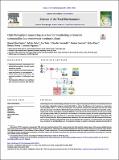Por favor, use este identificador para citar o enlazar a este item:
http://hdl.handle.net/10261/284656COMPARTIR / EXPORTAR:
 SHARE SHARE
 CORE
BASE CORE
BASE
|
|
| Visualizar otros formatos: MARC | Dublin Core | RDF | ORE | MODS | METS | DIDL | DATACITE | |

| Título: | High-throughput sequencing as a tool for monitoring prokaryote communities in a wastewater treatment plant |
Autor: | Ríos-Castro, Raquel CSIC ORCID; Cabo, Adrián; Teira, Eva; Cameselle, Claudio; Gouveia, Susana; Payo, Pedro; Novoa, Beatriz CSIC ORCID; Figueras Huerta, Antonio CSIC ORCID | Palabras clave: | Wastewater Microbiome Epidemiology DNA metabarcoding Mussel WBE |
Fecha de publicación: | 2023 | Editor: | Elsevier | Citación: | Science of the Total Environment 861: 160531 (2023) | Resumen: | In this study, the DNA metabarcoding technique was used to explore the prokaryote diversity and community structure in wastewater collected in spring and winter 2020–2021 as well as the efficiency of the treatment in a wastewater treatment plant (WWTP) in Ría de Vigo (NW Spain). The samplings included raw wastewater from the inlet stream (M1), the discharge water after the disinfection treatment (M3) and mussels used as bioindicators of possible contamination of the marine environment. Significant differences were discovered in the microbiome of each type of sample (M1, M3 and mussels), with 92 %, 45 % and 44 % of exclusive OTUs found in mussel, M3 and M1 samples respectively. Seasonal differences were also detected in wastewater samples, with which abiotic parameters (temperature, pH) could be strongly involved. Bacteria present in raw wastewater (M1) were associated with the human gut microbiome, and therefore, potential pathogens that could be circulating in the population in specific periods were detected (e.g., Arcobacter sp. and Clostridium sp.). A considerable decrease in putative pathogenic organisms from the M1 to M3 wastewater fractions and the scarce presence in mussels (<0.5 % total reads) confirmed the effectiveness of pathogen removal in the wastewater treatment plant. Our results showed the potential of the DNA metabarcoding technique for monitoring studies and confirmed its application in wastewater-based epidemiology (WBE) and environmental contamination studies. Although this technique cannot determine if the infective pathogens are present, it can characterize the microbial communities and the putative pathogens that are circulating through the population (microbiome of M1) and also confirm the efficacy of depuration treatment, which can directly affect the aquaculture sector and even human and veterinary health | Descripción: | 14 pages, 3 tables, 7 figures.-- Under a Creative Commons license | Versión del editor: | https://doi.org/10.1016/j.scitotenv.2022.160531 | URI: | http://hdl.handle.net/10261/284656 | DOI: | 10.1016/j.scitotenv.2022.160531 | ISSN: | 0048-9697 | E-ISSN: | 1879-1026 |
| Aparece en las colecciones: | (IIM) Artículos |
Ficheros en este ítem:
| Fichero | Descripción | Tamaño | Formato | |
|---|---|---|---|---|
| High_throughput_OA_2023.pdf | article | 4,24 MB | Adobe PDF |  Visualizar/Abrir |
| 1-s2.0-S0048969722076331-mmc1.xlsx | sup. table1 | 1,06 MB | Microsoft Excel XML | Visualizar/Abrir |
| 1-s2.0-S0048969722076331-mmc2.docx | sup. table2 | 21,15 kB | Microsoft Word XML | Visualizar/Abrir |
| 1-s2.0-S0048969722076331-mmc3.xlsx | sup. table3 | 1,96 MB | Microsoft Excel XML | Visualizar/Abrir |
| 1-s2.0-S0048969722076331-mmc4.xlsx | sup. table4 | 15,99 kB | Microsoft Excel XML | Visualizar/Abrir |
| 1-s2.0-S0048969722076331-mmc5.xlsx | sup. table5 | 31,75 kB | Microsoft Excel XML | Visualizar/Abrir |
| 1-s2.0-S0048969722076331-mmc6.docx | sup. figures | 1 MB | Microsoft Word XML | Visualizar/Abrir |
CORE Recommender
SCOPUSTM
Citations
5
checked on 04-may-2024
WEB OF SCIENCETM
Citations
2
checked on 25-feb-2024
Page view(s)
149
checked on 09-may-2024
Download(s)
93
checked on 09-may-2024
Google ScholarTM
Check
Altmetric
Altmetric
Este item está licenciado bajo una Licencia Creative Commons

